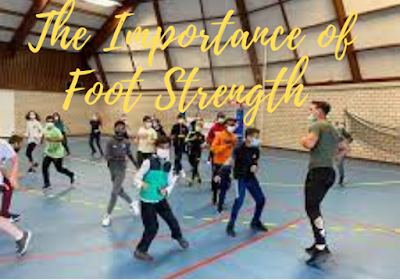As a personal trainer, I hear many concerns about lower body strength. Whether someone wants to play sports or simply wants to stay active, most clients want to have a stronger lower body. Hence, personal trainers often create complex lower body training programs utilizing a battery of leg/hip exercises. However, a closer look at these programs would expose a lack of emphasis on one important component of the lower body mechanical chain - the foot.
Why is the foot so important?
Although the muscle strength of the legs and the hips cannot be ignored, weakness in the foot will result in mechanical imbalance. The foot makes the initial contact with the ground. Therefore, the foot will dictate how the force will be translated up the mechanical chain (from the foot to the leg and, finally, to the trunk). In fact, the structure of the foot favours the task of mechanical translation. The bones and muscles of the leg are long and bulky. On the other hand, the bones and the muscles of the foot are generally small and in close proximity. For example, the mobility of the cuboid and the cuneiform, small cube-shaped bones forming the middle of the foot, allows the foot to change form. The foot's ability to change form allows the lower body to adapt to any surface, and by doing so, translates force up the chain so the rest of the leg can maintain the same pattern of mechanics. This allows us, for instance, to run relatively well on a variety of surfaces from concrete to grass or even sand. Hence, as we run on sand, for example, the foot will change form from step to step while the mechanics of the rest of the leg, like the knee, will remain fairly consistent.
Why is the foot rarely included in the exercise program?
The foot is rarely considered by personal trainers and fitness coaches when designing exercise programs. One reason is that the foot is rather unpredictable when compared to other structures in the body. As discussed, the foot can change form depending on the surface, the phase of the gait, or the level of balance. Therefore, it is difficult to assign an exercise and be certain what the exercise will do to these muscles. On the other hand, a personal trainer can predict what the shoulder will do fairly accurately when a client performs a shoulder press with a set of dumbbells. The foot also changes form in reaction to changes to inertia. For example, a basketball player who needs to quickly change direction will use his hips to push into the directions he needs to move to. The bones and muscles of the foot will take on the task of making fine adjustments that are needed to stay in balance and dictate what the hip muscles will do in order to maintain balance. Once the balance is achieved, the hips will do the work of moving the player into the designated direction.
The other reason why the foot is left out of an exercise program is more obvious. Once again, the muscles of the foot are small and are more designed for precise types of work. There is little immediate satisfaction gained from working the foot muscles. The burn on the glutes and quads is what clients want and pay for when they hire a personal trainer. In terms of calorie output (a reasonable concern when the goal is weight loss), the quads and glutes are better bang for the buck.
Mechanics of the foot
Although the foot is rather unpredictable, feet do follow two distinct mechanical paths: pronation and supination. Pronation is the ability of the foot to absorb force. As we plant the foot on the ground, the foot will take on a "spider web" like structure. In a nutshell, the foot begins to abduct and therefore increases its planting surface. Another important component is the planting of the big toe. The big toe creates a pivot around which the rest of the foot can absorb the weight. Interestingly, as this happens, the small muscles of the foot elongate. This allows the foot to store energy, similar to the action of a bow when stretched.
When the foot supinates it expresses the stored energy stored during the pronation. The cuboid and the cuneiforms clasp close together narrowing the foot. The close tightness of the cuboids and the cuneiforms reinforces the integrity between the metatarsals and the calcaneus. Hence, the foot turns into a stiff lever off which the body can propel.
How to train the foot
One must understand that the muscles of the foot are trained anytime we do leg/hips exercises while feet are planted. However, to further emphasise the foot, a good option are to exercise on one foot. These would include 1 leg squat and 1 leg deadlift. Another good option is trunk rotation while standing on one foot. While the trunk is SLOWLY rotating the foot will react by either abduction or adduction. These motions of foot abduction/abduction will help the pronation/supination continuum.
1 leg trunk rotation
-Stand on one foot
-Extend arms to a 90 at the shoulder
-While keeping the foot stable and planted, SLOWLY rotate from side to side
There are many

